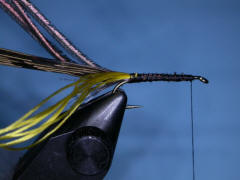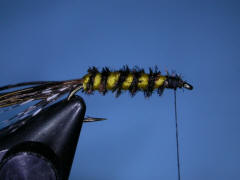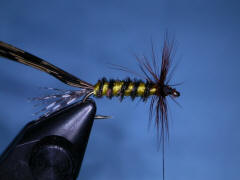|
Fly of
the Month
Bob Ireton brings together his
experience in fly fishing, aquatic entomology, and knowledge of fly
tying techniques and materials, to design and tie durable and
effective flies.
|

|

Volume 5, Issue 12
December 2004

TELLICO
NYMPH
Fly, Text, and Photography by Bob Ireton
This pattern originated on the Tellico River in
the Smoky Mountains about 75 years ago. The Tellico fly is mentioned in
the book ‘Trout’ by Rex Bergman, published in 1938. Back then, the
pattern called for a pale ‘blonde’ body. The originals were tied with
whatever materials that were handy at the time. About 30 years ago, the
body was changed to the present ‘yellow’. Some say this color change was
do to people starting to fish for trout using ‘corn’. This could very
well be. I would hope it was changed to yellow to resemble the yellow
stonefly nymph! The fly is now tied with many variations of patterns and
materials. For whatever reason, the Tellico is a consistent producer for
trout, smallmouth bass, sunfish, and other species of fish.
MATERIALS
Hook – Daiichi 1560, TMC 3761, Mustad
3906B, Dai-Riki 060, or Orvis 167.
Size – 10 – 18.
Thread – Black, UNI 6/0.
Tail – Guinea feather fibers.
Rib – Peacock herl, 3 strands.
Back – Ringneck Pheasant tail feather fibers.
Body – Yellow floss, 4 strand, doubled.
Collar – Furnace Hackle.
TYING STEPS - click on
pictures for larger view
|
1 - Place the hook properly in the vice. Pinch down
barb, if desired. I am using a Daiichi 1560, size 10, for this fly.
Start thread behind eye of hook, and lay on a tight thread base. Stop
above the hook barb, and tie a half hitch. You can add weight to this
pattern, so if you would like a weighted fly, apply the weight now.
|
 |
| 2 - Select some fibers from a Guinea
Fowl feather. Even up the tips, and tie in on top of the hook shank. The
length of the tail should equal the length of the hook shank. Tie a half
hitch. |
 |
|
3 – Attach the following components of the fly in the
order given. The peacock herl for the rib, the pheasant tail fibers for
the back, and the 4-strand floss, doubled, for the body. Even up the
thread wraps, and bring the working thread forward. Tie a half hitch.
|
 |
| 4 – Palmer the floss forward to form
the body. This step makes great use of a ‘rotary’ vice. Tie off the
floss, and snip off the excess. Tie a half hitch. |
 |
|
5 – Carefully twist the 3 strands of herl together to
form a rope. Now palmer this forward to form the segmented rib. Tie off
the herl, snip off the excess, and tie a half hitch. |
 |
|
6 – Select a piece of size 10 furnace hackle. Tie it
in behind the hook eye, and palmer around the fly to form the collar.
Tie off, trim off the excess, and tie a half hitch. |
 |
|
7 – Bring the pheasant tail feather fibers forward to
form the back. Hold in place and tie off. Snip off the excess fibers,
then form a head with the working thread. Tie a couple of half hitches,
then a whip finish. Cut off the working thread, and apply some head
cement. |
 |
© 2004 Robert R. Ireton, II
www.buckeyeflyfishers.com
Site designed and maintained by
Panfalone@fuse.net
|







